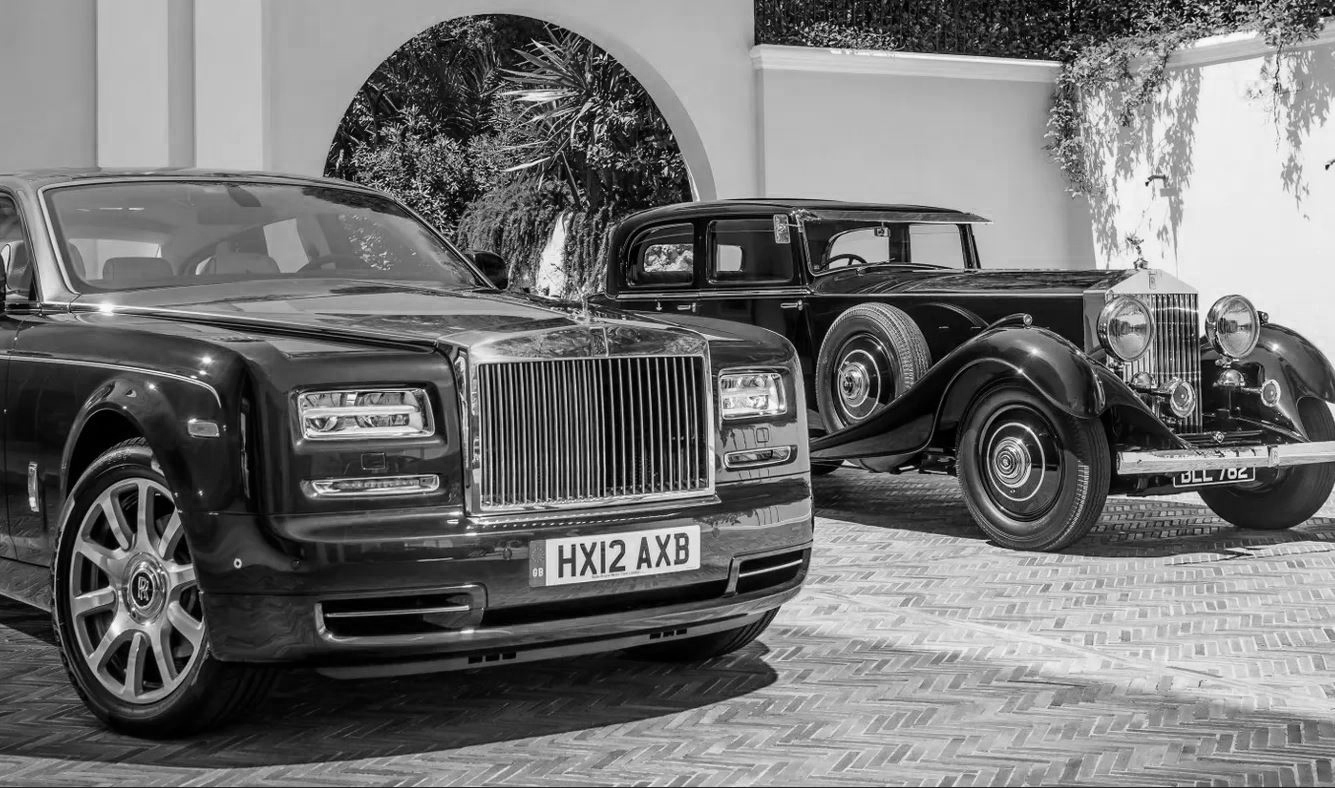Rolls-Royce a Century of Perfection
The turn of the 20th century marked the beginning of an extraordinary partnership between two of the most innovative minds of the moment. Henry Royce, a successful engineer and Charles Rolls, owner of one of the UK's first motor car dealerships, agreed to sell motor cars under the name Rolls-Royce.
At that moment, a new company was born: Rolls-Royce.
At that moment, a new company was born: Rolls-Royce.

The Best Motor Car in the World
In 1907, the Silver Ghost was declared 'The Best Car in the World' after its record breaking success. Travelling from London to Glasgow 27 times - covering 14,371 consecutive miles - the iconic motor car broke the world record for a non-stop motor run while demonstrating unrivalled reliability and comfort.
Despite earning the marque this legendary title, Silver Ghost was phased out in 1925 and replaced by New Phantom. Later known as Phantom I, this model was built in both the UK and USA.
1920-1929
The 1920s also marked the start of Rolls-Royce's contribution to aviation engineering. After the First World War and the opening of the first Rolls-Royce factory in Massachusetts, USA, the 'R' engine set a new world air speed record.
Developed for Britain's entry into the 1929 Intercontinental Schneider Trophy seaplane contest, it evolved into the Merlin engine, which later powered both the Spitfire and Hurricane.
Developed for Britain's entry into the 1929 Intercontinental Schneider Trophy seaplane contest, it evolved into the Merlin engine, which later powered both the Spitfire and Hurricane.

1930 - 1940
In the 1930s, Rolls-Royce broke world records on land and sea. And automation saw the arrival of Phantom III – the first ever Rolls-Royce to be built with a V12 engine. Travelling at 272.46 mph, Sir Malcolm Campbell broke the world land speed record in 1933 with Bluebird. But George Eyston smashed this time four years later by reaching 312.2 mph in Thunderbolt – a motor car powered by two Rolls-Royce 'R' engines. And Sir Henry Segrave broke the world sea record at 119 mph in Miss England II. Also engineered with 'R' engines, Sir Henry was killed moments later after colliding with a submerged tree stump.
Rolls-Royce improved the chassis of Phantom II, making it the first choice for the growing middle class who would cruise down to the south of France for the weekend. The same decade saw the launch of the first ever V12-engined Rolls-Royce – Phantom III.
1940 - 1950
The 1940s saw new developments in craftsmanship and design. Until 1959, each Silver Wraith had an individual, coach-built body.
Being constructed on a separate chassis meant that Silver Wraith bodies were heavy, so a 4,887cc engine was installed to cope with the weight.
When Silver Dawn came on the scene, it was the first Rolls-Royce sold with a standard steel body. Much lighter than the coach-built body of Silver Wraith, it was a pioneering effort from Rolls-Royce. While all steel-bodied models were exported, a few coach-built models still survive today and are highly collectible.
Being constructed on a separate chassis meant that Silver Wraith bodies were heavy, so a 4,887cc engine was installed to cope with the weight.
When Silver Dawn came on the scene, it was the first Rolls-Royce sold with a standard steel body. Much lighter than the coach-built body of Silver Wraith, it was a pioneering effort from Rolls-Royce. While all steel-bodied models were exported, a few coach-built models still survive today and are highly collectible.
1950 - 1960
The 1950s marked the start of a long-standing relationship between Rolls-Royce and the royal family.
Replacing Daimler as the preferred motor car supplier to the British monarchy, Her Royal Highness Princess Elizabeth took delivery of the first Phantom IV in 1950. Designed exclusively for royalty and heads of state, Phantom IV is one of the rarest Rolls-Royce motor cars in the world, with only 18 ever built.
The introduction of Silver Cloud came in 1955. Designed by JP Blatchley and capable of a top speed of 106 mph, it featured the same 4,887cc engine as Silver Dawn but with a completely new and handsome steel body.
By the end of the 1950s, Phantom V had arrived. Powered by a V8 engine and featuring a coach-built body, it was a huge success.
Replacing Daimler as the preferred motor car supplier to the British monarchy, Her Royal Highness Princess Elizabeth took delivery of the first Phantom IV in 1950. Designed exclusively for royalty and heads of state, Phantom IV is one of the rarest Rolls-Royce motor cars in the world, with only 18 ever built.
The introduction of Silver Cloud came in 1955. Designed by JP Blatchley and capable of a top speed of 106 mph, it featured the same 4,887cc engine as Silver Dawn but with a completely new and handsome steel body.
By the end of the 1950s, Phantom V had arrived. Powered by a V8 engine and featuring a coach-built body, it was a huge success.

1960 - 1970
By the time the Swinging Sixties began, Rolls-Royce had begun to appeal to a new breed of owner. Actors, rock stars and celebrities chose the marque as a symbol of their success.
Rolls-Royce also graced cinema screens. Sharing the limelight with Omar Sharif, Ingrid Bergman and Rex Harrison, a Barker-bodied Phantom II featured in the 1965 film, The Yellow Rolls-Royce.
In the same year, John Lennon bought a Phantom V. Leaving the factory with a plain white finish, Lennon had it repainted in matt black before opting for an outlandish, colourful design instead. Now, it's one of the most valuable items of pop memorabilia ever.
Rolls-Royce also graced cinema screens. Sharing the limelight with Omar Sharif, Ingrid Bergman and Rex Harrison, a Barker-bodied Phantom II featured in the 1965 film, The Yellow Rolls-Royce.
In the same year, John Lennon bought a Phantom V. Leaving the factory with a plain white finish, Lennon had it repainted in matt black before opting for an outlandish, colourful design instead. Now, it's one of the most valuable items of pop memorabilia ever.
1970 - 1980
The 1970s was a challenging decade for Rolls-Royce but, following re-launch as two separate companies, the decade saw the arrival of two exciting new motor cars.
Under Rolls-Royce Motors Limited, the stylish two-door Corniche was created. Based on Silver Shadow, it was hand-built by Mulliner Park Ward. Available as either a hardtop or a convertible, just 1,306 of them were built.
The Camargue, also by Mulliner Park Ward, was coach-built on a Silver Shadow platform with styling by iconic Italian coachbuilder, Pininfarina. The first Rolls-Royce designed to metric dimensions, it offered advanced features such as automatic split-level air conditioning.
Silver Shadow II was further enhanced with wrap-around black bumpers, an air dam below the front part of the motor car, and improved handling.
Under Rolls-Royce Motors Limited, the stylish two-door Corniche was created. Based on Silver Shadow, it was hand-built by Mulliner Park Ward. Available as either a hardtop or a convertible, just 1,306 of them were built.
The Camargue, also by Mulliner Park Ward, was coach-built on a Silver Shadow platform with styling by iconic Italian coachbuilder, Pininfarina. The first Rolls-Royce designed to metric dimensions, it offered advanced features such as automatic split-level air conditioning.
Silver Shadow II was further enhanced with wrap-around black bumpers, an air dam below the front part of the motor car, and improved handling.

1970 - 1980
The 1970s was a challenging decade for Rolls-Royce but, following re-launch as two separate companies, the decade saw the arrival of two exciting new motor cars.
Under Rolls-Royce Motors Limited, the stylish two-door Corniche was created. Based on Silver Shadow, it was hand-built by Mulliner Park Ward. Available as either a hardtop or a convertible, just 1,306 of them were built.
The Camargue, also by Mulliner Park Ward, was coach-built on a Silver Shadow platform with styling by iconic Italian coachbuilder, Pininfarina. The first Rolls-Royce designed to metric dimensions, it offered advanced features such as automatic split-level air conditioning.
Silver Shadow II was further enhanced with wrap-around black bumpers, an air dam below the front part of the motor car, and improved handling.
Under Rolls-Royce Motors Limited, the stylish two-door Corniche was created. Based on Silver Shadow, it was hand-built by Mulliner Park Ward. Available as either a hardtop or a convertible, just 1,306 of them were built.
The Camargue, also by Mulliner Park Ward, was coach-built on a Silver Shadow platform with styling by iconic Italian coachbuilder, Pininfarina. The first Rolls-Royce designed to metric dimensions, it offered advanced features such as automatic split-level air conditioning.
Silver Shadow II was further enhanced with wrap-around black bumpers, an air dam below the front part of the motor car, and improved handling.
New Horizons
The 1990s marked a new chapter in the marque's history when the BMW Group bought the rights to produce Rolls-Royce motor cars. With the change came a brand new manufacturing facility: the Home of Rolls-Royce at Goodwood. It was here that an exciting new chapter would begin.
Phantom, Ghost, Wraith, Dawn... Having set the benchmark for 21st century super-refined motor cars, Rolls-Royce is at the pinnacle of British luxury manufacturing. The development of an all-new motor car will now take the marque in an entirely original direction.
Phantom, Ghost, Wraith, Dawn... Having set the benchmark for 21st century super-refined motor cars, Rolls-Royce is at the pinnacle of British luxury manufacturing. The development of an all-new motor car will now take the marque in an entirely original direction.

Project Cullinan is Set to Astound
Adding another model to the marque, Ghost and Ghost Extended Wheelbase delivered simplicity out of complexity. Wraith followed and the world stood still. Then the endlessly sociable Dawn reimagined the open-top driving experience. Now Project Cullinan is set to astound.
Designed to deliver effortless comfort both on and off the road, Project Cullinan will be a high-bodied motor car with an aluminium architecture. As much about Charles Rolls' adventurous spirit as it is about Sir Henry Royce's dedication to engineering, it promises the effortless luxury synonymous with Rolls-Royce.
Electric History, Electric Future?
Today, many car manufacturers are developing electric alternatives to the combustion engine. But Rolls-Royce's exploration started 100 years ago.
It is no surprise then that Rolls-Royce created the 102EX, the Phantom Experimental Electric. This 2011 EX model was a one-off electric-powered Phantom that saw the 6.75-litre V12 engine replaced by a huge lithium ion battery pack and twin-electric motors driving the rear wheels. There were no gearshifts - just power, instantly, whenever you wanted it.
It is no surprise then that Rolls-Royce created the 102EX, the Phantom Experimental Electric. This 2011 EX model was a one-off electric-powered Phantom that saw the 6.75-litre V12 engine replaced by a huge lithium ion battery pack and twin-electric motors driving the rear wheels. There were no gearshifts - just power, instantly, whenever you wanted it.

Sir Michael Kadoorie is the Chairman of The Hongkong and Shanghai Hotels, Ltd. One of the groups hotels, The Peninsula in Hong Kong, has a fleet of 14 bespoke Rolls-Royce Phantoms which transport guests and dignitaries around the city. His family business, China Light and Power, is one of South East Asia's leading power suppliers. These credentials make Sir Michael the perfect person to give his opinion on 102EX- Phantom Experimental Electric. Watch this short film to discover his thoughts on this experimental vehicle and the future of the electric drive train.
Sir Michael Kadoorie on Electric-Powered Cars
